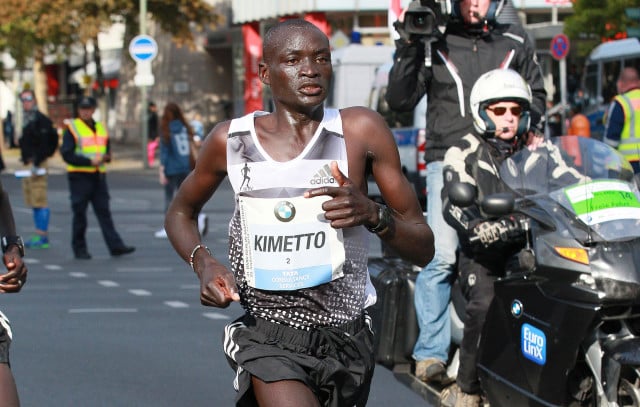Here’s Why the Sub-2 Marathon Guys Will Bonk
When it comes to marathoning, proper pacing rules. But to push the limits, the sub-2 runners must go out too fast. – By Amby Burfoot

There is a simple, four-part Golden Ratio that governs marathon pacing, and it will have a major impact on this weekend’s Nike Breaking2 marathon race in Italy.
The Golden Ratio is based on human physiology.
In other words, don’t mess with it. If you do, the ratio will bite you in the a**.
The four parts are these:
- If you start slow in a marathon, you have a good chance of finishing fast – you can run “negative splits,” quicker for the second 21.1 kilometres than the first 21.1.
- If you start at a reasonable goal pace, you can finish at the same pace – even splits.
- If you start too fast, you will finish too slow – positive splits.
- If you start way too fast, you will finish way too slow – disaster splits.
The Nike Sub-2 runners are going to start way too fast. They pretty much have to. After all, that’s the whole point of the experiment. And it’s worth noting here that this is indeed an experiment – run on a controlled course, with pacers and the works, and not on traditional roads like the races alluded to below.
Hence, according to the laws of human physiology, they will bonk badly in the second half of the marathon.
RELATED: Nike’s Audacious Plan: Break the 2-Hour Marathon Barrier in 2017
The three chosen runners – Olympic Marathon champ Eliud Kipchoge, half marathon world-record holder Zersenay Tadese, and two-time Boston winner Lelisa Desisa – have only one chance to succeed. They might break two hours if human ingenuity, i.e., science, can overcome human physiology. That’s the gamble that will be tested this weekend. Are the new Nike shoes far superior to anything seen before? Can an elaborate pacing scheme make a significant difference? Those are the two questions waiting to be answered.
At this point, we can’t know the outcome. But prior marathon history strongly argues against the sub-2.
To some extent, Mary Keitany jumped the gun and challenged the 2-hour barrier, relatively speaking, just over a week ago. In the 30 April London Marathon, she ran the first half of the course in a never-before-seen 66:54. That’s roughly equivalent to the Nike Breaking2 elites reaching halfway in 60:15, which is about what they figure to try for.
Keitany then ran five percent slower for the second half, 70:07, to achieve a final time of 2:17:01. If the Nike runners slow by the same five percent, their second half will be 63:20, yielding a final time of 2:03:40.
A slightly different analysis yields similar results. Let’s look at the fastest 21.1-kilometre split en route to a world-class marathon. That first-half record belongs to Kenenisa Bekele. In the 2016 Berlin Marathon, he went through halfway in 1:01:11, hoping to break the world record, 2:02:57. But Bekele, arguably the greatest distance runner of all time, slowed to a 1:01:52 for the second half. That left him six seconds over the record at 2:03:03.
The Breaking2 guys will likely be aiming for almost a minute faster than Bekele at halfway. According to the Golden Rule, they will then be way slower than the Ethiopian great for the second 21.1 kilometres. Let’s give them 60:20 and 1:03:30, or roughly 2:03:50 for a finish time.
This isn’t to say that they aren’t fit enough to run faster than 2:03:40 to 2:03:50. It only says that a suicidal first half leads not to a sub-2, but to a sub-optimal, performance.
The current world records for men and women, held by Kimetto and Paula Radcliffe, were both run with strong negative splits. Nike might find this a difficult model to follow, however, because if the guys start slow and then fail, they will be accused of having no guts. (If they follow the negative-splits approach, and succeed, they will be deemed geniuses.)
Dennis Kimetto, Berlin, 2014: 1:01:45, 1:01:12= 2:02:57
Paula Radcliffe, London, 2003: 1:08:02, 1:07:23= 2:15:25
By the way, Nike has rolled historical running dates into the equation, so let’s play that game too. The Breaking2 race will happen on close to the same date, May 6, when Roger Bannister produced the all-time greatest BreakingX performance.
The Breaking2 guys are hoping to better the marathon world record by three minutes. That would amount to a 2.4 percent improvement. Forget about the mighty Bannister. This is a far steeper hill to climb, more like Everest (first sumitted on May 29, 1953).
Still, who knows what a good pair of shoes and a pacing phalanx are worth? That’s why we’re all so excited about the Breaking2 race.
One more thing: Kipchoge just might be the greatest marathoner ever. If so, that’s a big additional factor. It gives us another reason to pay attention on May 6, 7, or 8. (Nike will hold the race on whichever date promises the best weather.)
READ MORE ON: sub 2 marathon



